Menu
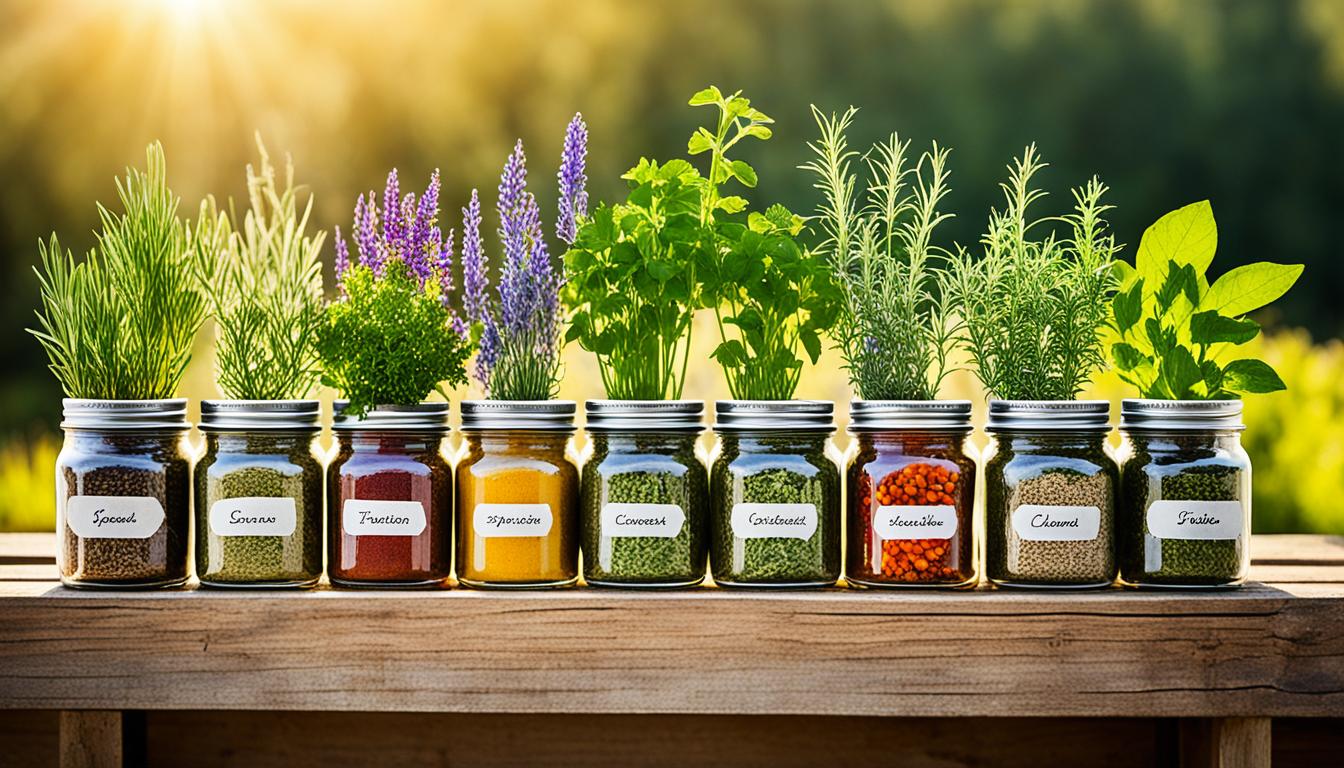
Store-bought spice blends can have a lot of preservatives and be quite expensive. This led me to try making my own blends. I wanted to make ordinary meals taste amazing.
Creating your own spice blends gives you control over flavours and what goes into your food. It’s not just cheaper and healthier. It also means you can get creative with the tastes you love. And by using herbs from your own garden, you’re supporting a sustainable way of cooking.
You can make these blends in the amount that suits you, perfect for personal use or as gifts. Making your own spice blends really boosts your cooking skills. It allows you to make dishes uniquely your own.
Making homemade spice blends is fun and makes our food healthier. It’s a step towards customised cooking without the bad stuff in store spice mixes. Choosing herbs from farms keeps my kitchen green.
Creating our own spice blends is cheaper than buying them from the shop. It also avoids the artificial bits I don’t want in my food. Plus, it makes every dish taste just how I like it.
I get to pick what’s in my blends. This means I can mix things up with spices like cumin or paprika. And I make just enough for what I need, so I don’t waste any.
Farm-grown herbs are key in my blends. They’re fresh and powerful, thanks to ethical farming practices. This makes my meals taste amazing and supports the planet too.
Different drying methods lock in the herbs’ natural flavours. Using herbs like rosemary or thyme makes my food smell and taste great. It’s all about the details.
Making your own blends saves cash over time. Bulk buying and using farm herbs are money-savers. Plus, I get to create mixes that match my taste perfectly.
Homemade blends are also healthier, with less salt and no bad additives. Sharing them as gifts shows you care. It’s a win-win for taste and health.
When you make your own spice mixes, you need more than just spices. Essential tools are important too. They help keep your blends consistent and well-mixed. Whether it’s Pumpkin Pie Spice or an Italian Seasoning, the right gear is key.
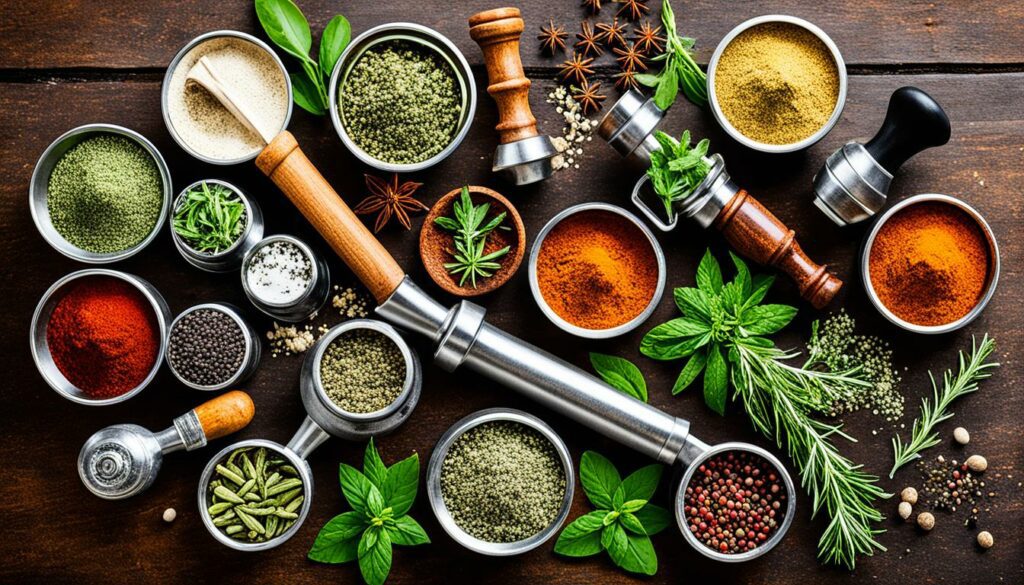
A mortar and pestle are old but gold for blending your spices. You can grind and mix manually. This gives you say over how fine or coarse the mix is. It also lets out more flavour.
For fine powders, a spice grinder is a must-have. It ensures your blend is smooth and even every time. This is especially important for mixes like Chai Spice or Taco Seasoning. Electric spice grinders make the job quicker but just as accurate.
To get your blends just right, use measuring cups and spoons. They guarantee you use the exact amount you need. While making Pumpkin Pie Spice or Taco seasoning, they keep your blends spot-on every time.
Need more guidance on making spice blends? Check out this detailed guide. By getting the right tools, you streamline your blend-making. This means tastier homemade spices.
The journey to creating your own spice blend starts with picking the herbs at the perfect time. This is usually mid-morning. It’s when the dew has gone, but the sun hasn’t taken away the oils. Late fall or early spring are great for taking roots.
The secret to potent farm-grown herbs is how they’re dried. Herbs that don’t have much water should be air dried. You do this by tying them in bundles and hanging them. But, if your herbs are moist, use a dehydrator to lock in their strength. Make sure roots and barks are completely dry to stop mold.
You can also dry herbs on screens or in baskets, which works well for small parts like flowers. However, never dry them in the sun as it can spoil their taste. After they’re dry, keep your herbs in airtight glass jars in a dark and cool place. If leaves break easily, they’re properly dry and can be stored.
Mark each jar with the herb’s name and drying date for better sorting. Late winter or early spring is perfect for starting your herb garden. This way, you can dry the herbs when they’re most flavourful. Having your herbs grown this way makes your spice blends more tasty and eco-friendly.
Adding a mix of herbs to your dishes can make them truly special. Use favourites like dill, thyme, coriander, or basil for a variety of tastes. For those with limited space, growing herbs in pots works well, as long as they get enough light.
Learn how planting certain herbs together can keep pests away, making your garden flourish. Either from seeds or as seedlings, focus on the quality of the plants. When picking the plants for use, select them before they flower or when they’re just starting to. Collect seeds when they’re fully grown but still dry. This careful method keeps your herbs full of flavour for your culinary adventures.
Making your own seasoning mixes opens up a world of taste. You can mimic the true flavours of Italy, Ethiopia, and Iran. Each mix, like the Italian, Ethiopian Berbere, and Iranian Advieh, has its own unique taste.
This Italian spice mix includes herbs like basil, oregano, and rosemary. It also has thyme and parsley. These herbs are key in Italian cooking. They make foods like pasta, soups, and meats taste like a trip to Italy.
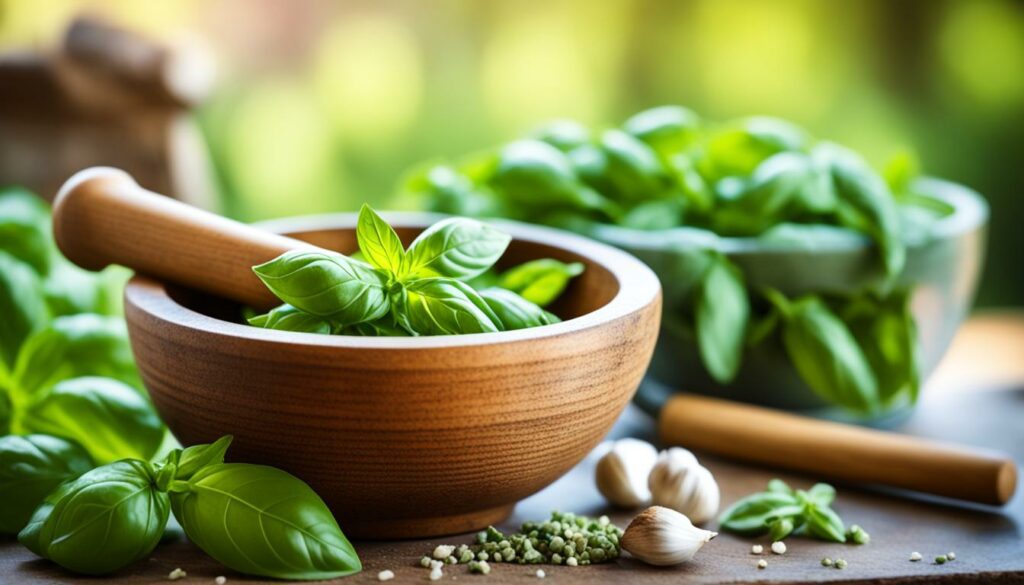
The Berbere spice blend comes from Ethiopia. It’s loved for its bold spice. This mix has spices like paprika, garlic, ginger, and more. It’s ideal for stews, lentils, and meat dishes. It adds a hot flavour to Ethiopian meals.
From Iran, the Advieh spice blend is a key part of Persian dishes. It has dried rose petals, cinnamon, and cardamom. This mix offers a sweet and fragrant taste. It makes Persian rice, stews, and meats smell and taste exotic.
These spice blend recipes take your cooking on a journey. You can explore the tastes of Italy, Ethiopia, and Iran, right in your home.
To keep your DIY spice blends fresh, you need to store them right. The key is picking the best spot. This ensures they keep their taste and power. Here, we share important tricks for storing your spice blends well.
Light can spoil your spices, making them less tasty and fragrant. It’s best to store them in a dark, cool place. A pantry or cupboard is perfect for this.
The right container is crucial. Glass jars are the top choice as they keep spices fresh and seal well. They don’t hold onto smells, unlike plastic.
| Container Type | Advantages | Disadvantages |
|---|---|---|
| Glass Jars | Non-reactive, airtight, retains flavour | Breakable |
| Plastic Jars | Durable, lightweight | Odour retention, non-airtight |
Always make sure your containers are clean and dry. This stops bacteria growth. Cleaning before and after use is a smart move for spice storage.
Making a note of what’s in your spice mix and when you made it is key. Add a date and list of ingredients for reference. A colour-coding system with stickers helps, too. Also, keep red spices like paprika in the fridge to last longer.
DIY spice blends can turn ordinary meals into taste sensations. They give you a taste of different cultures’ authentic dishes. You can try blends from the Middle East, India, or the U.S., each sharing its cultural story.
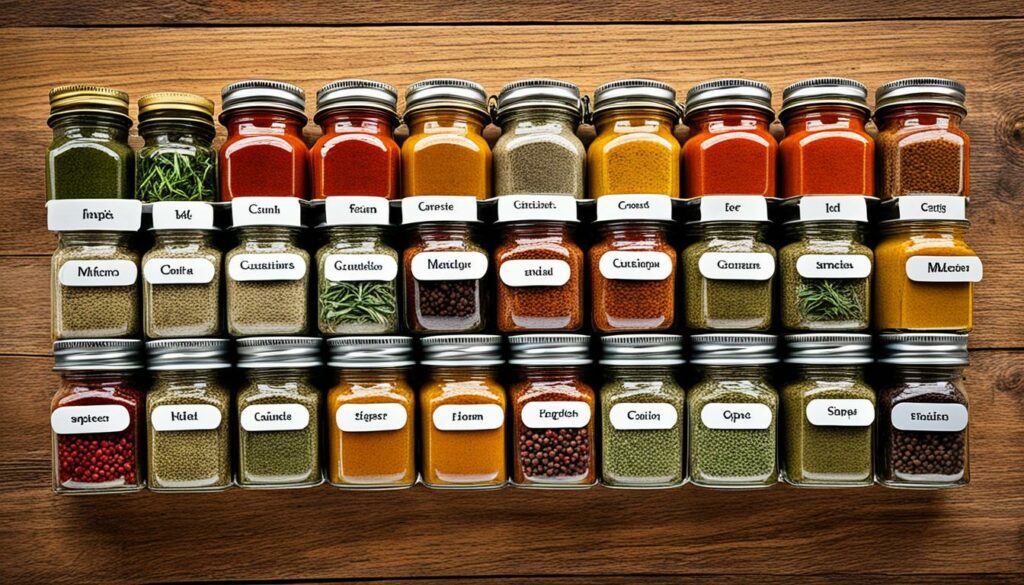
Middle Eastern blends like Za’atar and Dukkah add unique flavours. Za’atar uses thyme, sesame seeds, and sumac for a versatile blend. Dukkah, made from hazelnuts or sesame and spices, is great on bread, meats, or veggies. Both blends showcase the Middle East’s rich culinary traditions.
Indian blends offer a mix of warm and spicy flavours. Garam Masala is key in Indian cooking, with cumin, coriander, and more. Punjabi Cumin Mix adds a fiery touch to curries and stews. These blends bring out the bold tastes of Indian food.
American blends include BBQ Mix and Cajun Seasoning. BBQ Mix has paprika and brown sugar for a sweet, smoky taste. Cajun adds heat with garlic, paprika, and cayenne. They represent the rich flavours of American cooking.
Here’s a comparison of some blends and their ingredients:
| Spice Blend | Key Ingredients | Yield |
|---|---|---|
| Garam Masala | Cumin, Coriander, Cardamom, Pepper | 3-1/2 tbsp |
| Dukkah | Hazelnuts, Sesame, Coriander | 1/2 cup |
| BBQ Mix | Paprika, Garlic, Brown Sugar | 1 cup |
| Cajun Seasoning | Garlic, Paprika, Cayenne | 1/3 cup |
Using these blends in your cooking is like taking a trip with your taste buds. They offer a worldwide culinary adventure from your kitchen.
Make your own spice mixes to match your taste. Try different ingredients to personalise your dishes. Follow a few steps to get the right mix for each meal.
Changing the amount of each spice is key. For example, adding more mustard seed changes its taste. Use digital scales for accurate measuring. This makes your blends consistent every time you make them.
Adding rare herbs can make your blends stand out. Instead of just using basil and oregano, try Za’atar or star anise. You’ll discover new, exciting flavours by moving beyond the usual herbs.
Finding the perfect mix of spicy and mild is game-changing. For example, blends like Shag Carpet and Quiet Fire are great on roast chicken. Trying your mix on different foods shows its versatility. Don’t forget to clean out old spices to keep your blends fresh and potent.
Making custom spice blends is fun and creative. Keep tweaking your recipes, try new herbs, and mix up your flavours. Soon, you’ll have unique blends that you love.
| Cuisine | Common Herbs and Spices |
|---|---|
| Italian | Basil, oregano, rosemary, thyme |
| Indian | Turmeric, cumin, cardamom |
| Middle Eastern | Za’atar, cumin, coriander |
| Latin American | Chili powder, cumin, oregano |
| Asian | Star anise, Szechuan peppercorn, ginger |
Creating specialty spice blends is a culinary delight. It introduces new flavours, making meals unforgettable. These blends mix various spices and herbs. A good example is the popular Za’atar from the Middle East. Its ingredients include dried thyme, oregano, sumac, sesame seeds, and more. Each adds a unique aroma to the blend.
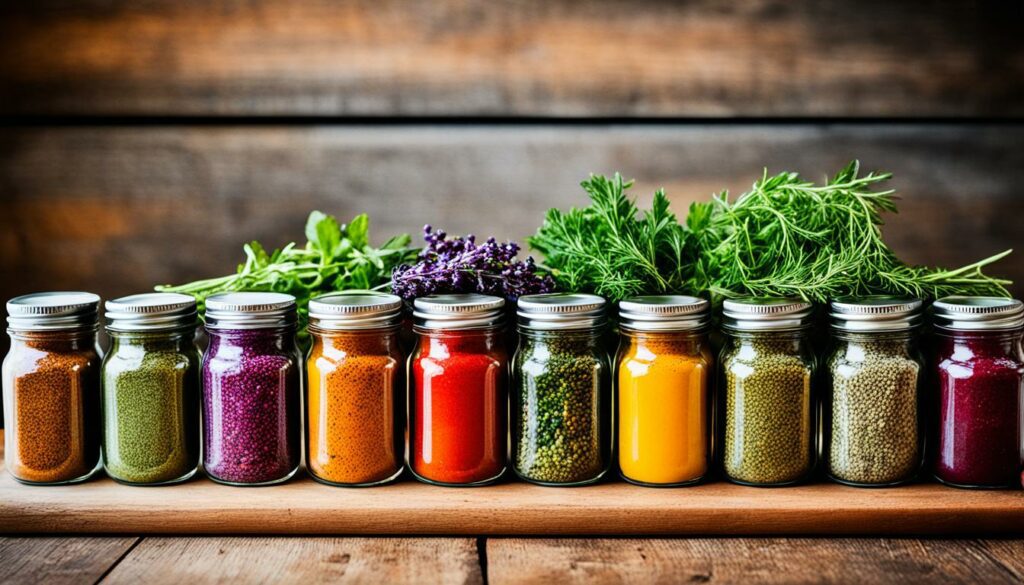
North African cuisine values Ras el hanout. It combines black pepper, white pepper, and many more spices. This mix adds depth and warmth to tagines and stews.
For a taste of India, try Garam masala. It’s a mix of cinnamon, cumin, cloves, and nutmeg. A key spice in Indian cooking, it brings warmth and sweetness to dishes.
Jerk seasoning from the Caribbean is fiery. It uses Scotch bonnet peppers, allspice, nutmeg, and more. Jerk chicken and pork are famous for their intense taste because of this blend.
Chili powder can be made special with a mix of different spices. A blend of garlic powder, paprika, and more can make meals extraordinary.
Specialty spice blends vary in cost. Prices range from $7.20 to $14.12. Yet, even the most economical options offer great taste.
Considering Italian Seasoning at $9.68 or Lemon Pepper at $10.80 adds zest to dishes. These blends are key in creating unique meals. Just a sprinkle can turn any meal into a gourmet adventure.
The Forest Flavour Mix brings the scents of a woodland into your kitchen. It’s an amazing blend you can make yourself. This mix adds unique flavours to any meal. I’ll show you the ingredients, how to make it, where to use it in recipes, and how to store it.
Making the Forest Flavour Mix is simple and fun. You’ll need these ingredients:
Mix all ingredients well in a big bowl. Then, store in an airtight container to keep them fresh.
This blend can make many dishes taste better. For a delicious start, use it in a wild mushroom soup. It’s also great to sprinkle on roast chicken for deep, earthy flavours. Use it in broths for a strong forest taste that makes food more interesting.
Keep your blend fresh for longer with these tips:
Following these simple rules will help your mix stay full of flavour. It’ll be ready to make your dishes smell like the wild forest.
| Blend | Key Ingredients | Usage |
|---|---|---|
| Forest Flavour Mix | Nettle leaf, mugwort, shiitake powder, garlic, juniper berries | Soups, roasts, broths |
| Hedgerow Spice Blend | Juniper, wild fennel, fir needles, spicebush berries | Meat rubs, stews |
| Riverbank Blend | Staghorn sumac, wild bee balm, pine nuts | Salads, fish, za’atar substitute |
| Woodland Seasoning | Porcini, chanterelles, shiitake, juniper berries | Mushroom dishes, roasts |
| Coastal Sprinkle | Dulse, wakame, nori seaweed, sea lettuce | Seafood dishes, salads |
Adding organic herbs to spice blends has many advantages. The top one is they’re grown without synthetic pesticides and chemicals. This makes the flavours stronger and safer to eat. Using organic herbs brings out natural tastes and smells that often disappear in regular spices.
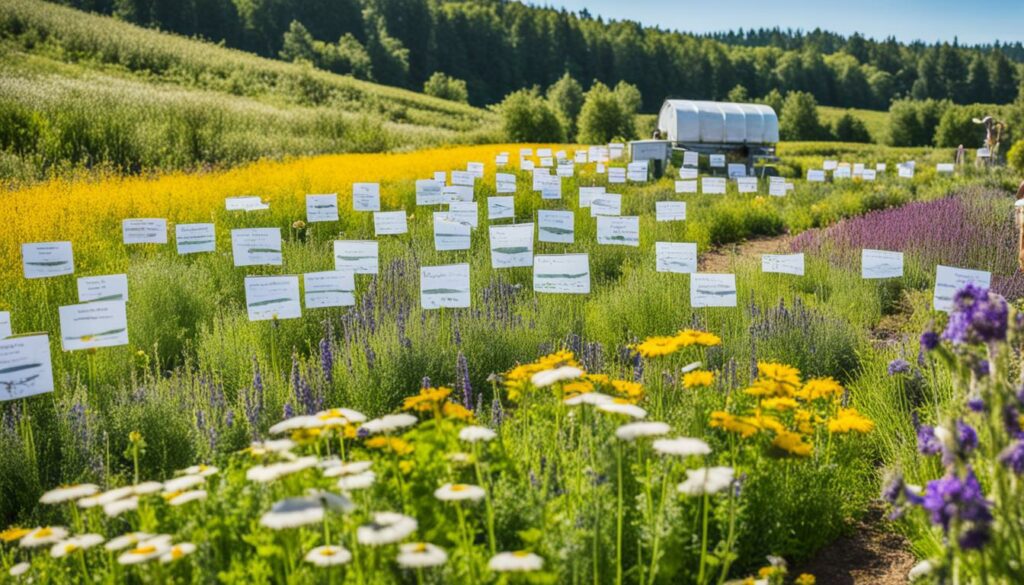
Buying organic herbs and spices in bulk can save you money over time. It’s great for places like restaurants, cafes, and catering because it cuts down their costs and makes more money. Plus, buying in bulk is good for the planet as it reduces the amount of packaging thrown away.
Organic spices and herbs are packed with more vitamins and minerals. They grow in soil that’s full of nutrients. Also, choosing organic helps to keep water clean, prevents soil from washing away, and protects animals.
If you like making your own spice blends, organic herbs let you create unique flavours. This is very good when cooking for different tastes or dietary needs. It’s a smart move for chefs and anyone who loves good food.
| Conventional Herbs | Organic Herbs |
|---|---|
| Contain synthetic pesticides | Free from harmful chemicals |
| Grow in normal soil conditions | Grown in nutrient-rich soil |
| May lack intense flavours | Retain natural flavours and aromas |
| Limited in nutrient content | Higher nutrient density |
Making your own spice blends lets you keep your cooking pure. You can avoid the bad stuff like additives and preservatives from shops. These can have a harmful effect on your health, so it’s good to know what you’re cooking with.
In 1982, the International Agency for Research on Cancer said that bad carrageenan can cause cancer in animals, showing it’s not good for people either. Soybean oil is another concern, possibly leading to cancer, heart problems, weakening the immune system, and gaining weight. By steering clear of these, you’re cooking in a way that’s better for your body.
Homemade mixtures with no harmful additives help with tummy problems that can come from bad stuff like carrageenan. Studies on animals show that these can make your gut more inflamed. So, choosing natural spices means you can cook in a way that helps your tummy and your overall health.
Using natural preservatives means your spice mixes can last longer without losing their health goodness. Things like salt, vinegar, and special oils help keep the spices fresh. For example, Magic Seasoning blends in the US have been around for more than 25 years. They’re all-natural, gluten-free, and have no MSG or unnatural preservatives.
Following these steps in your cooking means you can enjoy the health benefits of spices without the bad stuff. This falls right in line with what Chef Paul Prudhomme believes. He thinks you should pick spices for their flavour and quality, not just the price. This way, you get healthier and tastier food.
| Additives | Health Impact | Natural Alternatives |
|---|---|---|
| Carrageenan | Carcinogenic Risk, Inflammatory Intestinal Impact | Salt, Vinegar |
| Soybean Oil | Cancers, Heart Disease, Immune System Impairment, Weight Gain | Olive Oil, Coconut Oil |
Handing over a handcrafted spice blend isn’t just about the taste. Packaging these blends in beautiful ways makes them extra special. It makes the person getting the gift feel very important and loved.
Choosing special jars for your spice blends shows you care. You can use old candle jars, repurposed into spice holders, to add a warm, rustic feel. Add custom labels to make them unique. You can also use baby food jars, which are affordable and cute, to hold smaller portions. Dress them up with ribbons and tags.
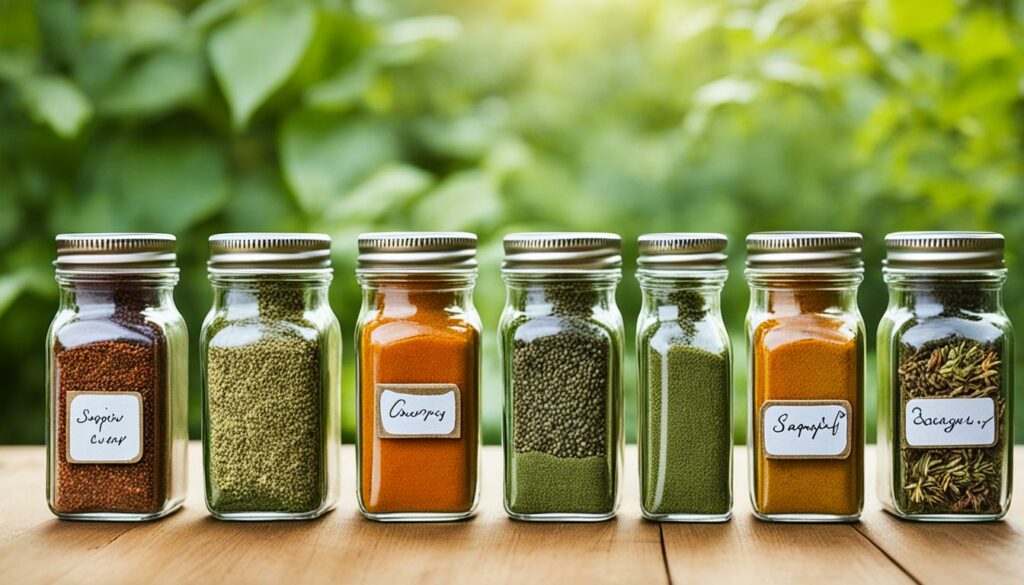
Include recipe cards with your spice blends for a lovely touch. It makes your gift more than just spices. The cards give ideas for using the blends. For example, a Lemon Pepper recipe could include instructions for making it.
This helps the person use your gift in the best way.
Themed spice gifts are fun for any event. You could do a set like a Caribbean Jerk Mix. This might include spices like onion powder, sea salt, thyme, and cayenne pepper. Put them in Mason Jars that keep the spices fresh for a neat presentation.
| Item | Cost | Best Use |
|---|---|---|
| Repurposed Candle Jars | $5 each | Decorative and Eco-friendly Packaging |
| Baby Food Jars | Low-cost | Small Spice Blends |
| Mason Jars | $2.50 each | Airtight Storage for Blends |
The real fun in giving these gifts is the whole experience. With pretty jars, fancy recipe cards, and theme sets, you make your gifts unforgettable. It’s about more than just the taste; it’s about the thought and creativity you put into it.
DIY spice blending is not just fun – it’s practical, money-saving, and healthy. Mixing your spices gives your food a personal touch. It also helps keep your cooking consistent and flexible. Spice mixes make meal prep faster and easier for anyone.
When you blend spices yourself, you’re in charge. You can adapt the flavours to match any diet or taste. This means you can make dishes that please both veggies and meat lovers. It’s a great way to meet different food needs.
Keeping your spice mixes in good condition matters a lot. Put them in airtight containers, away from light and heat. This keeps them good for up to a year. Using the best, freshest spices makes your meals smell and taste amazing.
DIY mixing brings many good things. It saves money, boosts nutrition, and adds fun to cooking. It starts a journey to creating flavours that are all your own. Every food you make can be a special, gourmet treat.
Making your own blends lets you create unique tastes. It also saves money and keeps your food pure. You’ll enjoy making dishes just the way you like them.
Farm-grown herbs make your spice mixes more delicious and healthy. They’re fresher and haven’t been treated with bad chemicals. Plus, it supports the planet.
You’ll need a mortar and pestle, a spice grinder, and measuring tools. These help you get the right texture and mix your spices well.
Pick herbs in the morning when they’re dry but not too hot. Dry them naturally for some kinds, or use a dehydrator for others. This keeps the flavours strong.
Sure. Try Italian, Ethiopian Berbere, or Iranian Advieh spice blends. They capture the true flavours of their regions.
Keep your blends in a dark, cool place in glass or safe containers. Label them with a date to know when to use them by.
For Middle Eastern food, make Za’atar and Dukkah. Indian dishes shine with Garam Masala and Punjabi Cumin Mix. Americans love BBQ mix and Cajun spice.
Try different spice amounts and add unique herbs. Mixing spicy with mild helps in creating your perfect blend.
Speciality blends are made for certain meals and can really make them stand out. They turn simple food into something special.
The Forest Flavour Mix brings a wild taste to your cooking with dried nettles, mugwort, and juniper berries. It’s great in soups, on roast chicken, or as a base for a filling broth. Keep it sealed and dark for the fullest flavour.
Organic herbs make your blends taste better and are safer for you and the Earth. They guarantee fresh, pure flavours.
By making your own mixes, you control what goes in. Use salt and vinegar to keep them fresh without any bad stuff.
Pack them in fancy jars with your own labels and add recipe cards. Thematic kits for different kinds of food or events are great for gifts.